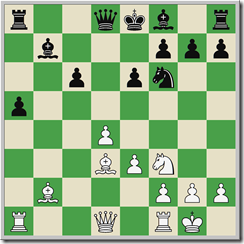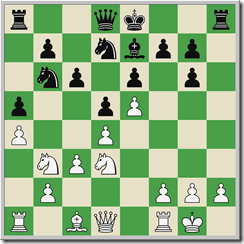This review has been printed in the June 2018 issue of Chess Life. A penultimate (and unedited) version of the review is reproduced here. Minor differences may exist between this and the printed version. My thanks to the good folks at Chess Life for allowing me to do so.
—–
Ramesh, R.B. Fundamental Chess: Logical Decision Making. Los Angeles: Metropolitan Chess, 2017. ISBN 978-0985628161. PB 288pp.
Since winning the World Junior Championship in 1987 and becoming the first Indian Grandmaster in 1988, Viswanathan Anand has almost single-handedly defined chess in India. His rise to the World Championship was eagerly followed by his countrymen, chess fans and lay-people alike, and his 2013 match in Chennai was, despite Anand’s loss to Magnus Carlsen, a huge boon to Indian chess.
Anand’s example served as an inspiration for an entire generation of Indian chess players, including Grandmaster Ramachandran Ramesh – “R.B. Ramesh” as he is widely known – who served as a commentator for the 2013 match. He was the first Indian to win the British Open Championship in 2002, earning his Grandmaster title a year later. In 2014 Ramesh captained an Indian Olympiad team that won its first medal (bronze, open section) in that nation’s history, and he currently coaches the Indian U16 and Olympiad teams.
Having retired from active competition in 2008, today Ramesh is one of India’s leading chess trainers. Among his students are R. Praggnanandha, the youngest International Master in history at 12 years old, and the 18 year old Grandmaster Aravindh Chithambaram. He has also launched an online chess academy at chessgurukul.com and at nurtr.com, with the ultimate aim of offering chess training to all comers, regardless of ability to pay. If Anand is responsible for the current popularity of chess in India, it will be trainers like Ramesh who will shape its future.
Now Ramesh has written a fine new book, Fundamental Chess: Logical Decision Making, published by Metropolitan Chess Publishing out of Los Angeles. As its title suggests, the book offers readers a thoughtful, didactic account of over-the-board decision making. I enjoyed it immensely.
At its root, chess is all about decisions. We use various tools – principles, logic, calculation – to make the best choices we can in the time we have available to us. If we make better decisions than our opponent, we win. If not, well…
Chess training, on Ramesh’s telling, is designed to teach us to use all of the tools available to us in the decision making process. His emphasis is practical – after all, as he notes, “knowing is NOT doing!” (25) – and in this, he echoes the philosophy of Mark Dvoretsky, whom he mentions in the Introduction (6-7) as an important influence on his teaching and playing.
Ramesh cites a rather famous game between Carlsen and Aronian from the Bilbao Grand Prix in 2008 to begin to unpack his point.
Here Carlsen played the amazing 15.d5!!, and Ramesh writes:
I remember checking this position with an engine and 15.d5 was its 31st choice! Does this make d5 good or bad? … Carlsen came up with the surreal move 15.d5!! to open up the dark-squared bishop and to create attacking chances against the Black king, temporarily stuck in the center of the board. It is not unusual for strong players to give up a pawn for the initiative. But would the mere knowledge of this principle convince us to play this move in an actual game? I think not. (11)
[For the record, the game continued: 15. …Nxd5 (if (a) 15…cxd5? 16.Bb5+ Nd7 17.Ne5 Bc8 18.Qh5 g6 19.Qf3 and White should win; (b) 15. …exd5 is met with 16.Nd4 where White has ideas of Qa4 and Nf5 with full compensation; and (c) 15. …Qxd5 is answered by 16.Ne5 Bb4 (16. …Bd6 17.e4 Qc5 18.Rc1 with initiative) 17.Qa4 0–0 18.Rfd1 and White has the initiative)
16.Ne5 Nf6 (after 16. …Be7 17.Qh5 g6 18.Qh6 Bf6 19.e4 Nb6 20.Rab1 and White has the initiative) 17.Qa4 Bb4 18.Nxc6 Bxc6 19.Qxc6+ Ke7 20.Rfd1 and White has good compensation for the pawn. Aronian resigned after the 36th move.]
How did Carlsen decide to play such a move? There are, I think, some terminological difficulties in Ramesh’s account, but he seems to argue something along these lines. Neither brute calculation nor intuition – defined as “the output of our knowledge, experience, and confidence at that point in time” (16) – alone could have guided Carlsen’s choice. Both are required to accurate assess a nebulous concept like compensation, and particularly in such a complex position.
Ramesh contends that “young players” will often depend heavily on either calculation or intuition when they should harmoniously consult both. In the course of his discussion, however, he appears to argue that there is a tendency today towards the calculative pole of this dialectic, especially among the young, and that the training of “logical, intuitive thinking” is a necessary counterbalance. Such training is achieved through “accumulating more knowledge and experience in various types of positions.” (16)
Fundamental Chess: Logical Decision Making is clearly constructed with this goal in mind. In Part I (“Logical Reasoning”) Ramesh tries to unpack the nature of our thought processes, and Chapter Two, entitled “The Problem of Choices,” is perhaps the core of the book. We are faced with the necessity of choosing between multiple reasonable moves in most non-critical positions, and most of us, I suspect, would admit that this can be the source of no small angst over the board!
Ramesh offers general advice for such situations: we use a ‘scanning technique’ to make a broad list of possible moves, which we prune by process of elimination. We analyze forcing continuations to see if any tactics exist, and we try to remain practical in our decision-making. Ultimately, as he puts it, “[c]ontradictory principles occur all over the board… We need to choose the principle appropriate to the position at hand in order to find the best move or a decent plan.” (68) To me this sounds like an argument for training intuition in a more traditional sense.
Part I is largely a series of annotated examples that unpack elements of our decision making and thought processes. Part II (“Practical Chess Play”) turns to more practical applications of logical reasoning, again through the use of illustrative examples. Chapters are devoted to topics like the initiative, conversion of advantages, and prophylaxis, but I was most interested in Chapter 9, “Playing on Colors.”
Talk of color complexes and weaknesses has always been somewhat opaque to me, and good explanations of what is meant by a “dark-square weakness” are lacking in books on chess strategy. Here we get a ‘teacherly’ exposition of how to approach the topic, focusing mostly on the bishops, and I want to quote Ramesh’s summary at some length before turning to one of his examples. (Thanks to Metropolitan Chess for granting permission to use these passages in this review.)
Here is a general guide for knowing which color to play on, depending on the situation:
1. Same colored bishops for both sides: Only the bishops should focus on their colors. All the other pieces should play on opposite colors. For example: if both sides have dark colored bishops, we should put all our other pieces on light squares.
2. Two bishops versus bishop and knight: The side with the two bishops should play on the colors where the opponent does not have a bishop. The side with the bishop and knight should play on the color of the bishop.
3. Opposite colored bishops: Both sides should play on the colors of their bishops.
4. One bishop versus one knight: The side with the knight should play on the opposite color of the opponent’s bishop. The side with the bishop should utilize his other pieces on the opposite color of the bishop.
5. Both sides have both bishops: When the central pawns are fixed on a particular color, we should play on the opposite color of our opponent’s centralized pawns, and try to exchange the opponent’s bishop of that same color. For example: if the opponent’s center pawns are fixed on light squares, then we should exchange the dark colored bishops and fight for the dark colors with other pieces. (208-209)
Ramesh follows this with eight examples, each demonstrating some element of this general framework. The discussion of the first position, taken from Polzin-Motylev (Bundesliga, 2008), is typical of both Ramesh’s style and analysis:
14. …Nc4 Both sides have dark-squared bishops, so they should try to put their other pieces on light squares.
15.Qe2 b5 White at some point could kick the c4-knight with b2-b3, so Black aims to put his pawn on a4 to stabilize the c4-square for his knight. Moreover, if Black castles on the kingside, where he does not have as many defenders, it is possible that White could launch a direct attack with f2-f4, g2-g4 and f4-f5. Hence Black wants to secure adequate counterplay on the queenside before he makes the decision to castle short. If things get too hot on the kingside, then he could consider keeping his king in the center or even sending it to the queenside if necessary.
16.axb5 cxb5 17.f4 Qb6 18.Nd2 If White tried to launch an attack immediately with 18.g4 then Black would have adequate resources: 18. …a4 19.Nd2 Qc6 20.f5 gxf5 21.gxf5 exf5 and Black is much better … [note that] 22.Rxf5 is impossible in view of 22…Qg6+.
18. …Qc6 19.Nf3 a4 With a small advantage, Black went on to win from here. In this example, Black not only used his pieces but also his pawns to gain control over the light squares on the queenside.
Part III (“Fundamentals of Chess Training”) is devoted to general training advice – how to study the opening, how to prepare for tournaments, how to understand the endgame, etc. – and what I would call Ramesh’s ‘philosophy of improvement.’ Many teachers warn their students not to worry about their ratings. Borrowing from the work of Mihaly Csikszentmihalyi and classical Indian philosophy, Ramesh persuasively argues that such worry has deleterious effects on our results and, more importantly, our enjoyment of the game.
Parts I and II are very concrete in nature, offering readers dozens of examples to illustrate key teaching points. Part III is, in contrast, almost all text. There is a lot of interesting and inspirational material here, to be sure, and Ramesh’s trademark optimism is especially apparent in these pages. Still, the book feels somewhat disjointed, and Part III feels in some ways like an afterthought or appendix to the main part of the book.
This is particularly true in Chapters 11 and 17, where Ramesh discusses the proper use of the computer in opening study. ChessBase is not an intuitive piece of software to use, and instruction should involve specific how-to’s and illustrative screenshots. Instead we get text-only renderings of database screens and opening trees. It’s an opportunity missed, and one that would have been very easy for the editors to fix.
Fundamental Chess: Logical Decision Making is a vastly ambitious book, covering wide swaths of chess philosophy and practice. Such enthusiasm makes its small flaws rather forgivable. Its target audience – “younger players,” or, in Ramesh’s system, those rated 1500-2400 (!?) – is very wide, and one could argue that the book tries to cover too much ground. But I would much rather read an enterprising work than a limited, modest one, and at the end of the day, the author has given us a book that will reward multiple rereadings. Well done, “Ramesh sir.”

